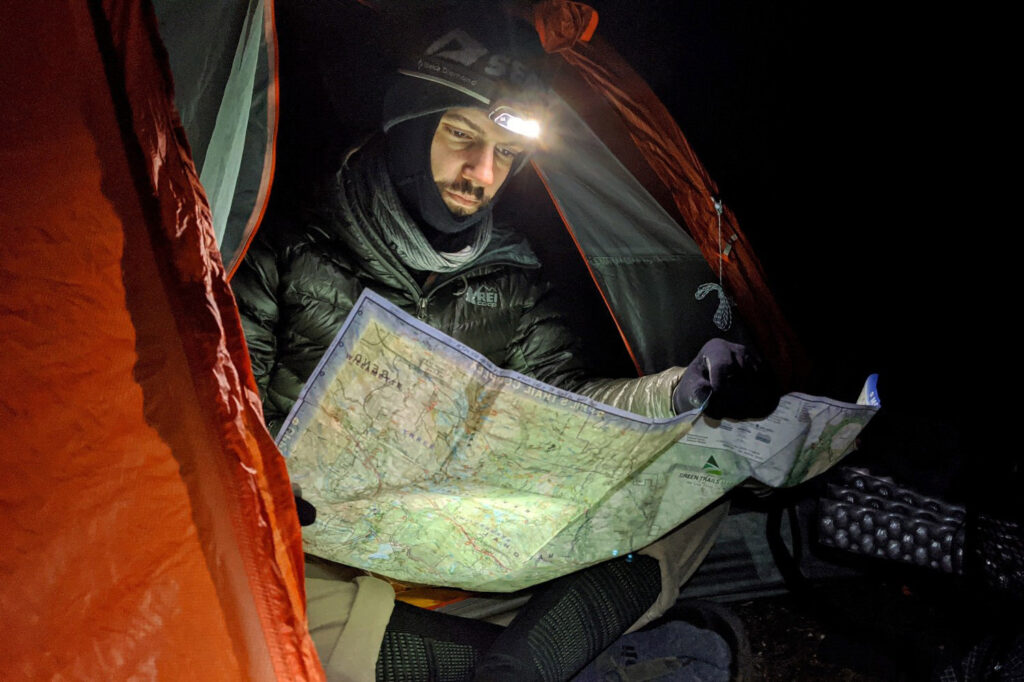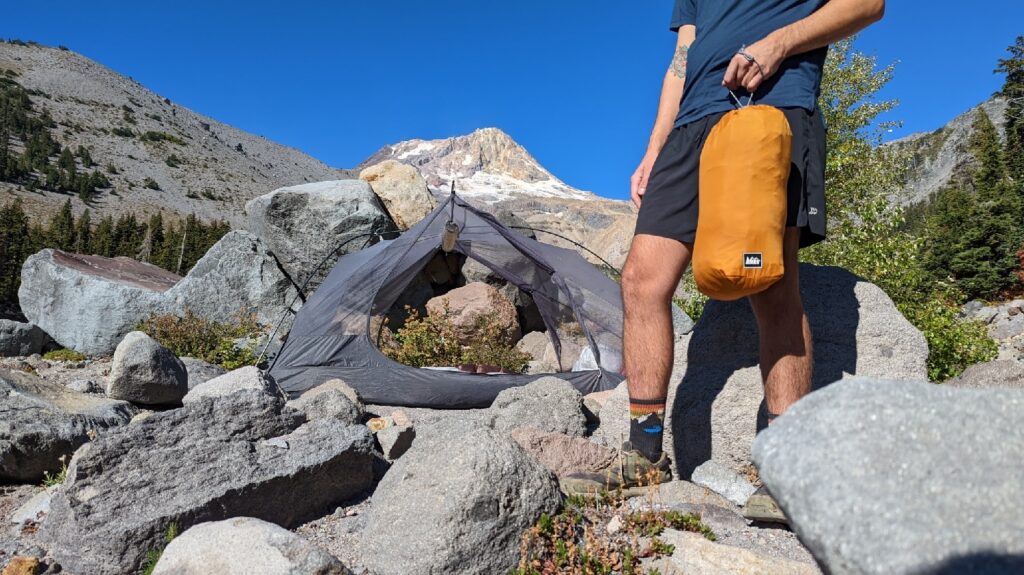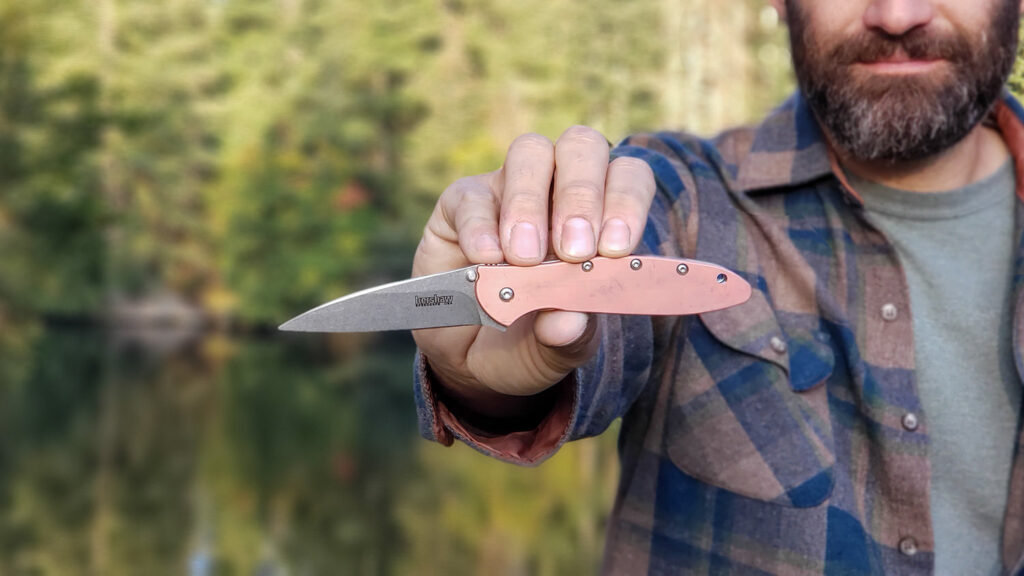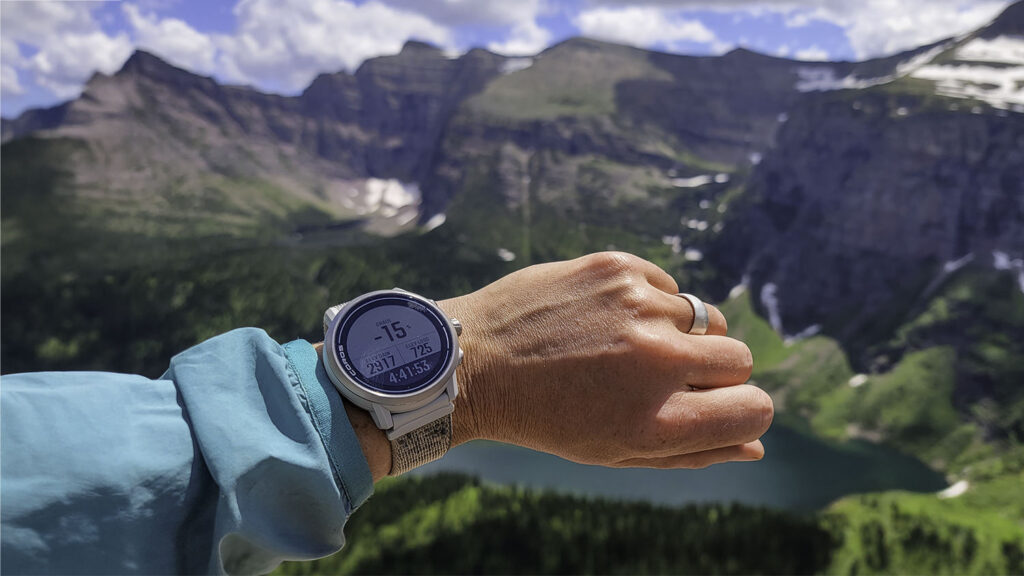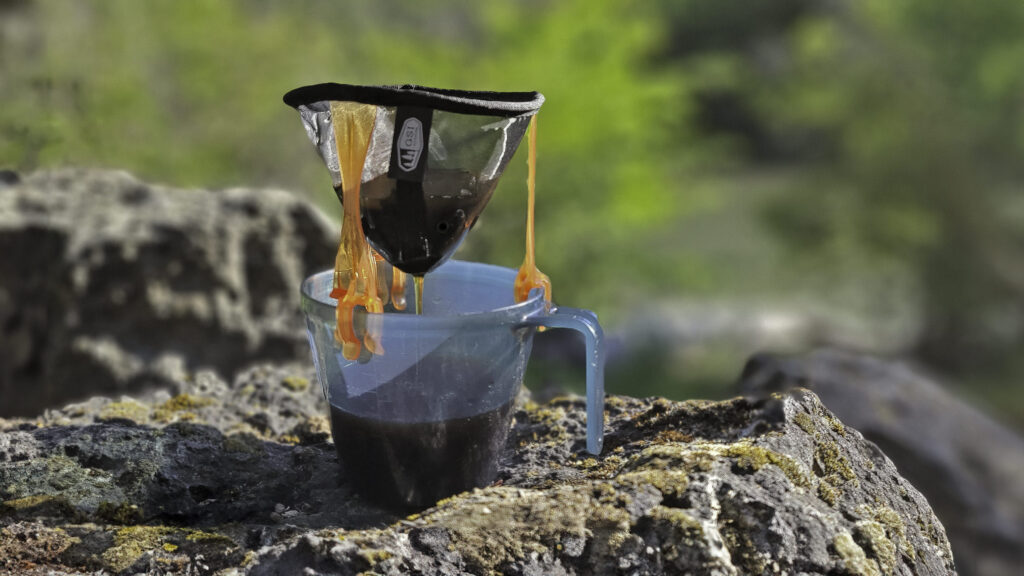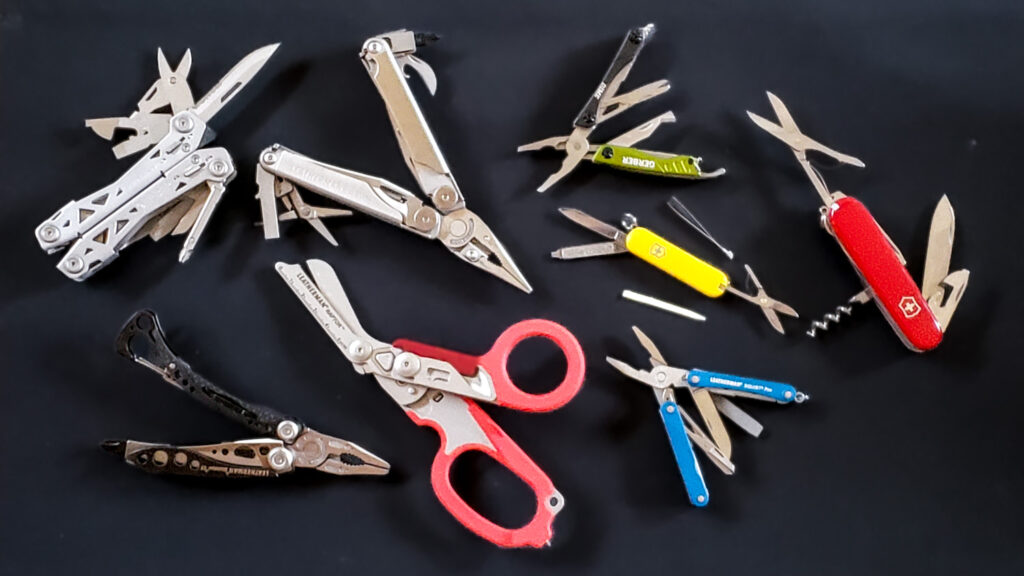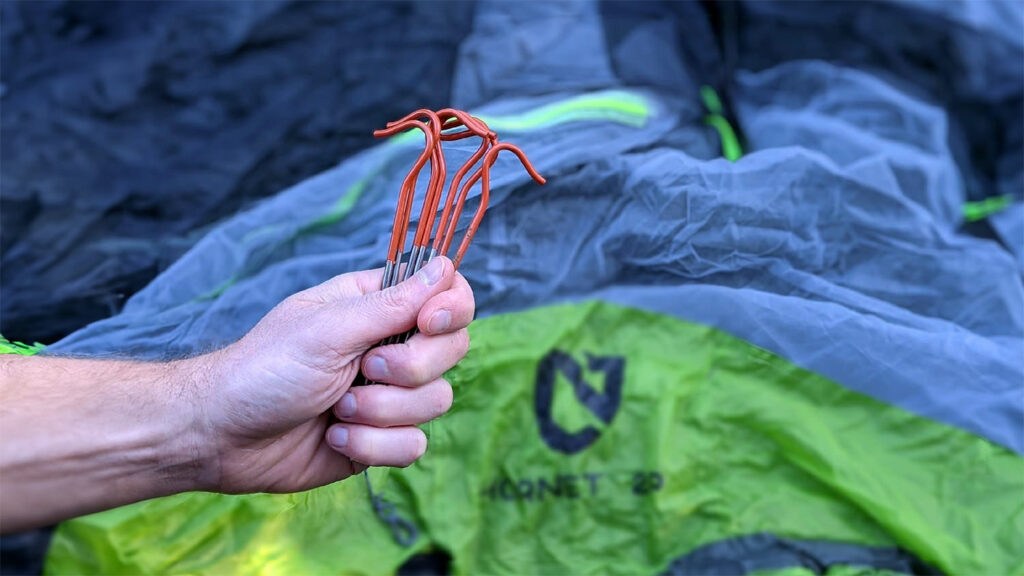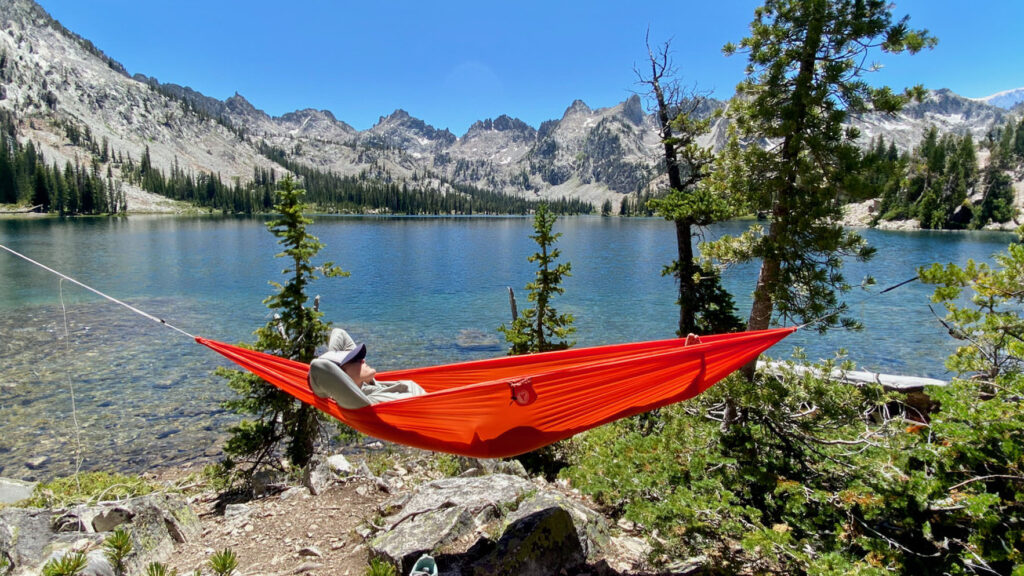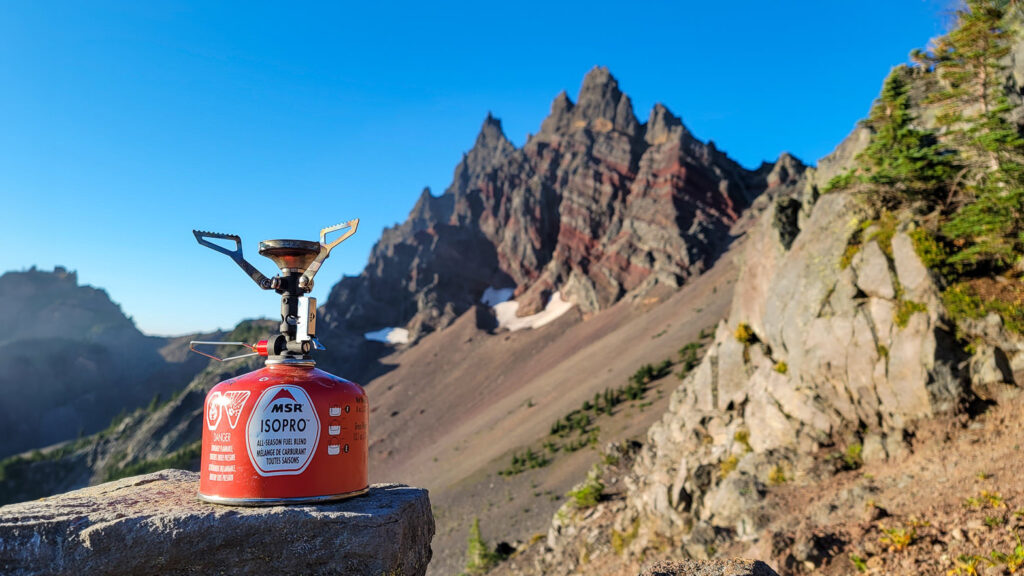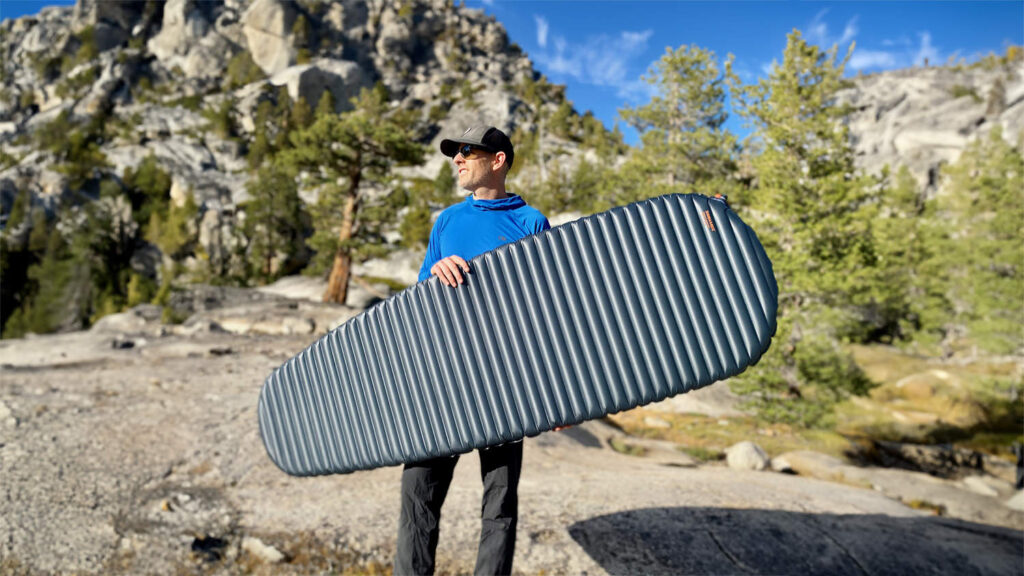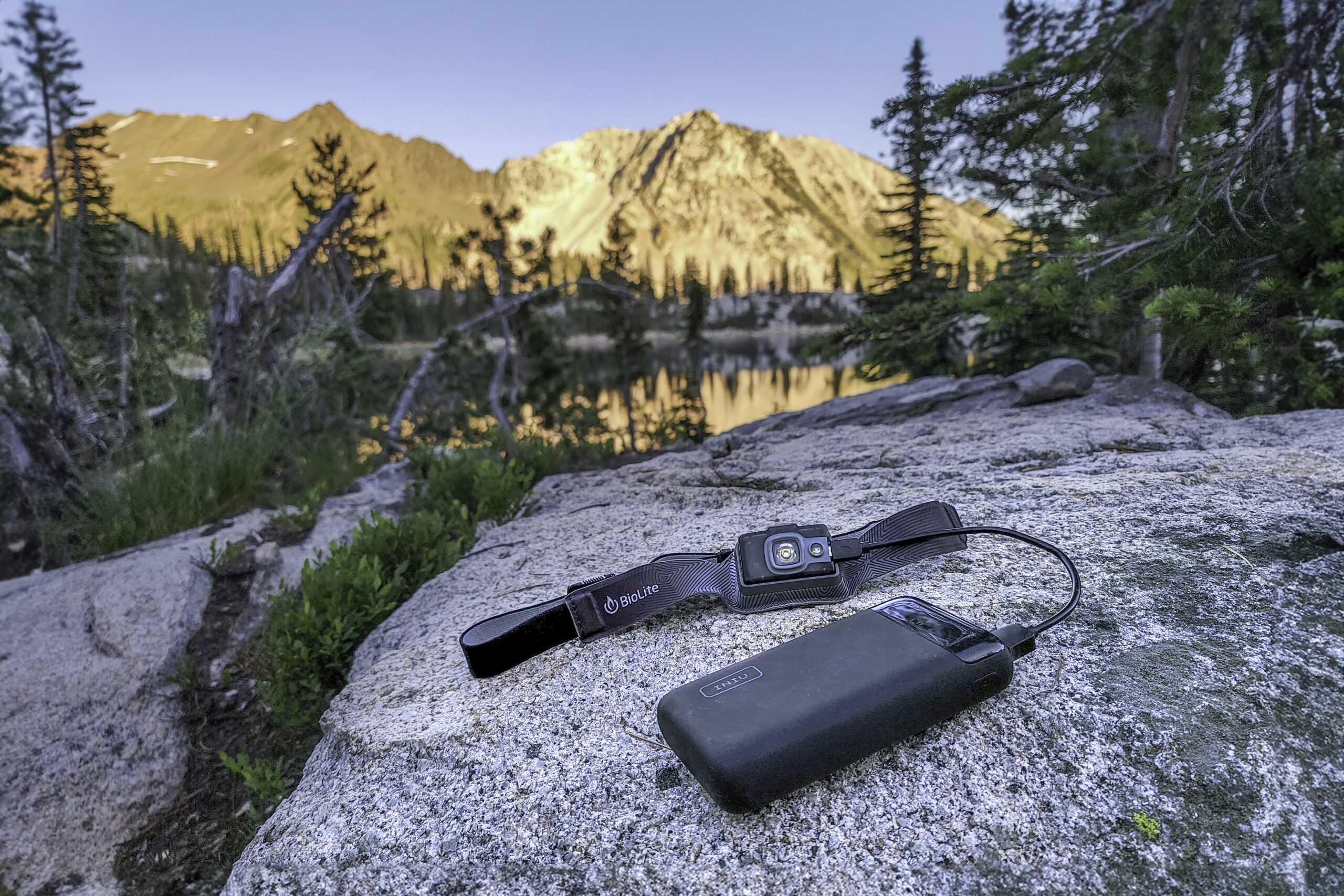
Electronics are essential items in many hikers’ backpacks, so getting the best power bank to keep them going on trail is really important. Whatever your electronics setup looks like, we know it can be a real drag when something runs out of juice in the backcountry.
We’ve researched more than 40 power banks over the last four years, and tested 25 of the most promising battery packs on trail to bring you this guide. Whether your charging needs are extensive or you just need a simple battery to top up your phone every once in a while, our expertise will help you find the best power bank for your adventures.
And for more info, check out some of our other popular gear guides:
Quick Picks for Power Banks
Check out this quick list of our favorites if you’re in a hurry, or continue scrolling to see our full list with in-depth reviews.
Best Power Bank Overall: Nitecore NB 10000 Gen 3 ($65)
Best Budget Power Bank: OKZU 10000 ($26)
Best Single-Charge Power Bank: Goal Zero Flip 24 ($30)
Best Compact Power Bank: Zendure Super Mini ($30)
Best Power Bank with Bonus Features: INIU Megapower 10000 ($25)
Best 20000 mAh Power Bank: INIU 20000 PD ($30)
Best Value Power Bank: Miady AS-TPB21 ($22)
Best Large-Capacity Power Bank: Charmast 26800 ($35)
Incredibly Reliable Power Bank: Anker PowerCore Slim 10000 ($15)
Best Durable Power Bank: BioLite Charger 80 PD ($80)
Best Power Bank for Charging Large Devices: UGREEN 145W ($100)
What’s new
After logging more miles with our top power bank picks and testing some new ones, we’ve made some updates to our list:
- The new Nitecore NB10000 Gen 3 moves to a top spot with its incredible efficiency to weight performance, lightweight, and portability.
- The OKZU 10000 is one of our favorites for its fast recharge time and one of the most affordable price tags.
- We added several new power banks to our testing lineup, including the two-pack Miady and the incredibly portable Zendure Super Mini 10000.
Power Banks Overall Testing Scores
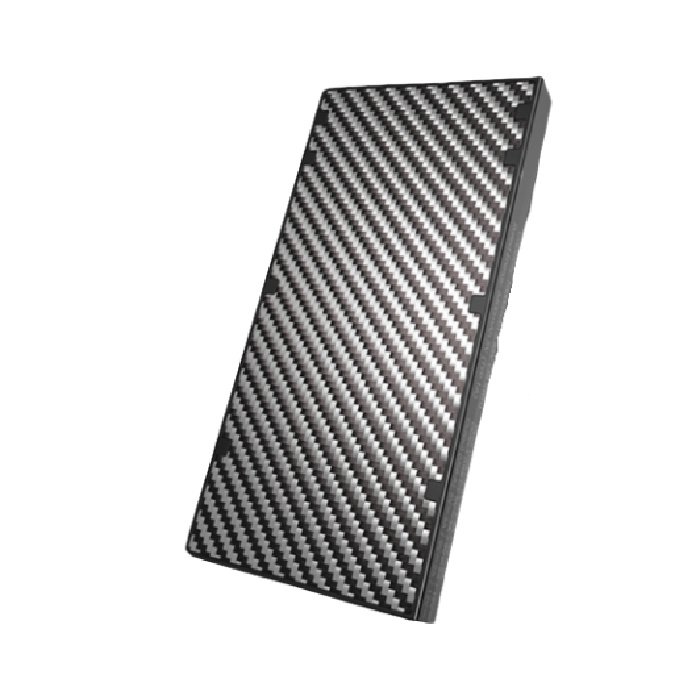
Nitecore NB 10000 Gen 3
Best Power Bank Overall
CleverHiker Rating: 4.9/5.0
Price: $65
Weight: 5.3 oz.
mAh: 10,000
Time to full charge: 4 hrs (USB-C)
Pros
- Compact
- Ultralight
- Durable
- Recharges quickly
- Quick charge output
- Pass-through charging
- Can charge two devices at once
Cons
- Expensive
- Battery life indicator isn’t very clear
One of the lightest, most efficient, and most portable power banks on the market, it is no wonder that the Nitecore NB10000 Gen 3 is one of our favorite models. While testing the Nitecore for several weeks, we had the opportunity to put it on our scale, run it through some efficiency and charging tests, and bring it along with us on backpacking trips in the San Juan Mountains.
We love how easy it is to bring along due to its small size and it’s minor weight penalty makes it a fantastic choice for ultralight purists. It also packs a punch with the most number of Watt hours available per ounce of any power bank we tested. It is a bit pricier, but in this case we feel that hikers get what they pay for when it comes to the Nitecore.
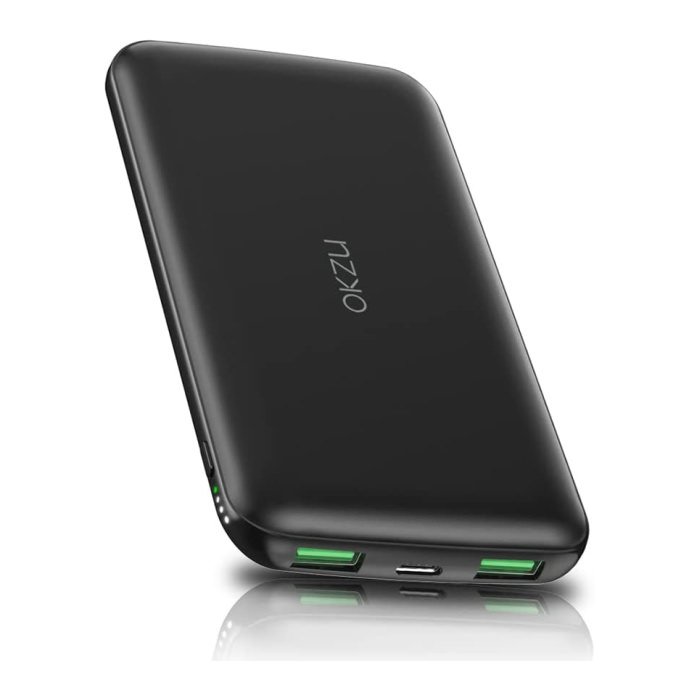
OKZU 10000
Best Budget Power Bank
CleverHiker Rating: 4.8/5.0
Price: $24
Weight: 6.6 oz.
mAh: 10,000
Time to full charge: 3.5 hrs
Pros
- Affordable
- Ultralight
- Recharges quickly
Cons
- Only charges one device at a time
- Loses charge in the cold
The OKZU 10000 is a solid power bank that performs reliably in various metrics, smashes the competition in recharging time, and only has a few weaknesses. Considering its price, it is among the best choices for those looking to balance cost and performance.
We like that the OKZU was the fastest model to recharge from dead to full, coming in at a speedy two and a half hours. It had a respectable weight when placed on our scale and its power output is above average on a per-ounce basis. After weeks of use and being dropped on the ground, it continues to work as normal and has enough features to make it useful for the average user. What it lacks in portability and cold tolerance can be easily overlooked in most situations.
More: OKZU 10000 Full Review
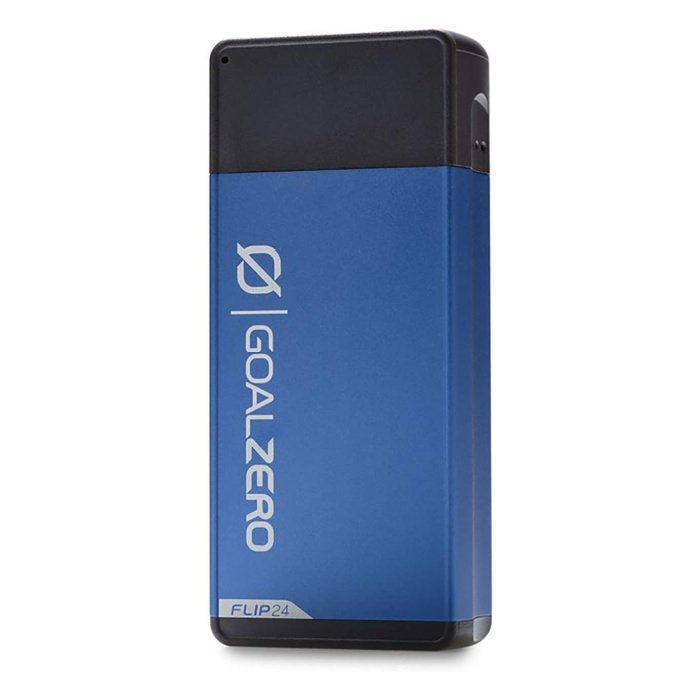
Goal Zero Flip 24
Best Single-Charge Power Bank
CleverHiker Rating: 4.7/5.0
Price: $30
Weight: 4.8 oz.
mAh: 6,700
Time to full charge: 4 hrs
Pros
- Affordable
- Compact
- Ultralight
- Built-in USB-A plug
Cons
- Low amount of power in comparison to weight
- Small charging capacity (charges the avg. phone 1x)
- Power input can be hard to use
The only power bank with a built-in USB plug that we tested, the Goal Zero Flip 24 is great for hikers who just need one full charge. Because of its smaller capacity, the Flip is exceptionally lightweight, portable, and quick to recharge. We often choose this power bank on our backpacking trips because it easily fits in any pocket and is not as cumbersome as most of the larger-capacity power banks.
Though we wish it was more efficient on a power-per-ounce basis, it performs well in colder temperatures, ranking near the very top of the pack. One thing to note, the built-in USB plug can be difficult to use as the port is close to the main body of the bank and it dangles in the air when plugged in. Ultimately, Goal Zero is a sturdy battery pack ready to go anywhere, anytime.
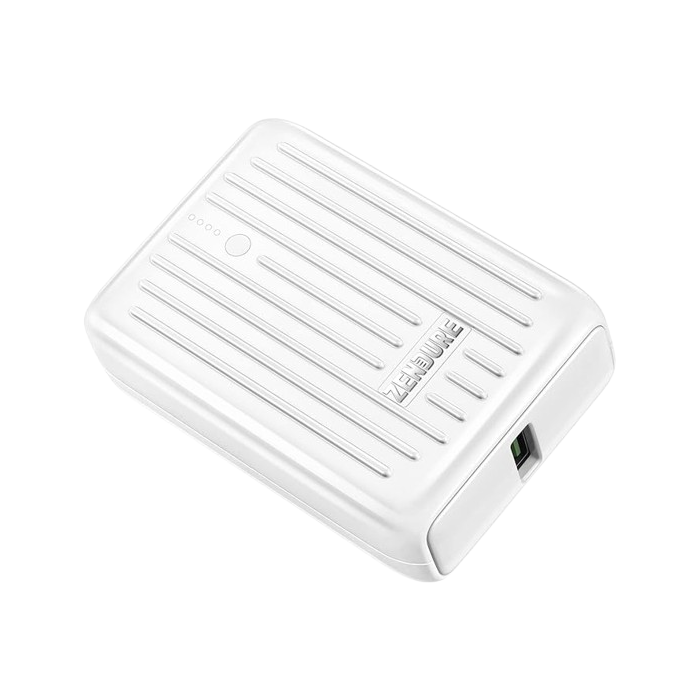
Zendure Super Mini 10000
Best Compact Power Bank
CleverHiker Rating: 4.6/5.0
Price: $27
Weight: 6.6 oz.
mAh: 10,000
Time to full charge: 3 hrs
Pros
- Fits in hand easily
- Low voltage mode for small electronics
- Ultralight
- Simple design
Cons
- Charge indicator is hard to read
- Only two ports
- Efficiency could be better
Offering a simple, streamlined design and easily one of our lineup’s most portable power banks, the Zendure Super Mini 10000 is an excellent option for those who like to use their power bank on the go. During our tests, we found that the Zendure is one of the lightest models and it came in second place in the 10,000 mAh category. That, paired with its incredibly portable design, make it one of our preferred power banks for charging while hiking or placing devices in tent pockets that have a predisposition to sag.
Even with added usage during the day, the Super Mini shows very few cosmetic signs of use and can stand up to the rigors of the outdoors. We also like that it recharges fast so we can get back on the trail quickly. All of these pros do come with a few cons. The Zendure does not have the best efficiency for example, but it does make up for it by performing well in cold weather. And at its price point, it seems hard to go wrong with this power bank.
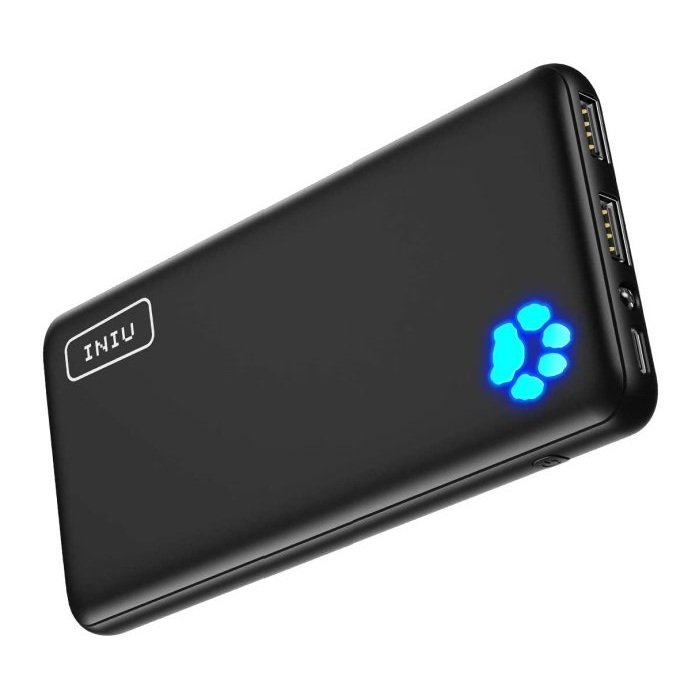
INIU Megapower 10000
Best Power Bank with Bonus Features
CleverHiker Rating: 4.5/5.0
Price: $30
Weight: 7 oz.
mAh: 10,000
Time to full charge: 5 hrs (USB-C)
Pros
- Affordable
- Often on sale
- Recharges quickly
- Clear analog charge indicator
- Built-in flashlight
Cons
- Slightly heavier due to features
- Easy to accidentally turn on flashlight
For a slight weight, portability, and performance penalty, the INIU Megapower 10000 offers solutions to problems in other top-performing 10,000 mAh power banks. We love that this power bank recharges quickly, saving us time so that we can spend more time on the trail and less in town.
The Megapower’s pass-through charging capabilities and multiple charging ports also add convenience. This power bank has decent power efficiency, and it is easy to tell how much battery is left with an easy-to-read analog display. The best part? The INIU Megapower 10000 has an affordable price tag, making it an excellent choice for those on a budget.
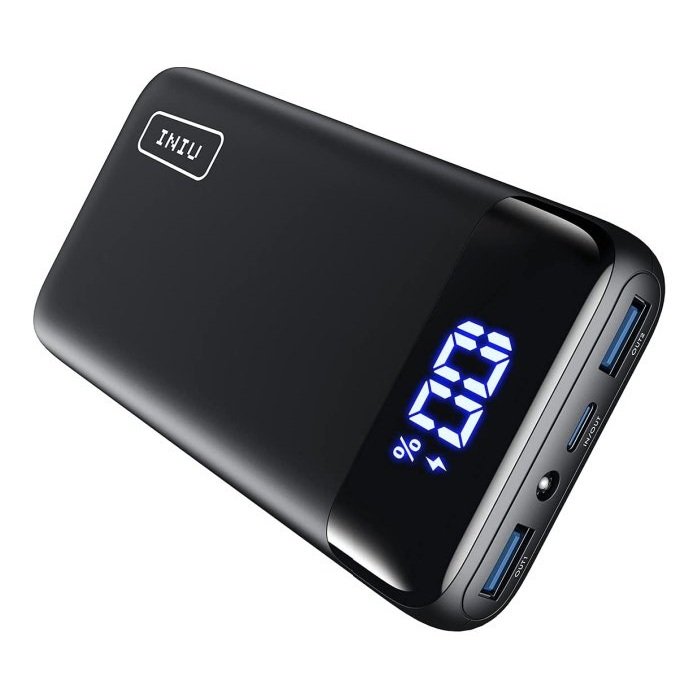
INIU 20000 PD
Best 20,000 mAh Power Bank
CleverHiker Rating: 4.4/5.0
Price: $33
Weight: 12.2 oz.
mAh: 20,000
Time to full charge: 6 hrs (USB-C)
Pros
- Very affordable
- Lots of power in comparison to the weight
- Decent charging speed compared to size
- Large digital battery display
Cons
- Poor performance in cold weather
- A bit bulky
In order to account for the larger size and weight of a bigger battery, the best approach to looking at the INIU 20000 PD is through the lens of a 20,000 mAh power bank. Compared to 10,000 mAh battery packs, its performance levels typically won’t stand up due to its larger battery size. Larger capacity power banks are a different matter: it is a strong contender and one of our favorite picks.
Overall, it is our second-best large-capacity power bank in weight, charging speed, and portability, and it ranks as the best 20,000 mAh power bank in many other categories. In the field we found that it fit nicely in our hands due to its shape and volume. On our scale, it also had a very modest weight in comparison to the size of the battery. When we timed how long it took to recharge, the INIU 20000 PD spent five and a half hours filling up with juice which seems pretty reasonable given it will recharge a phone fully nearly four times.
Speaking of charges, we like that it is the second most efficient power bank out of all the banks we tested, which means you get a lot of power for what is being carried. While it does struggle to stay efficient in colder temperatures, many of the features it offers and a very affordable price tag make this model stand out for us.
More: INIU 20000 Full Review
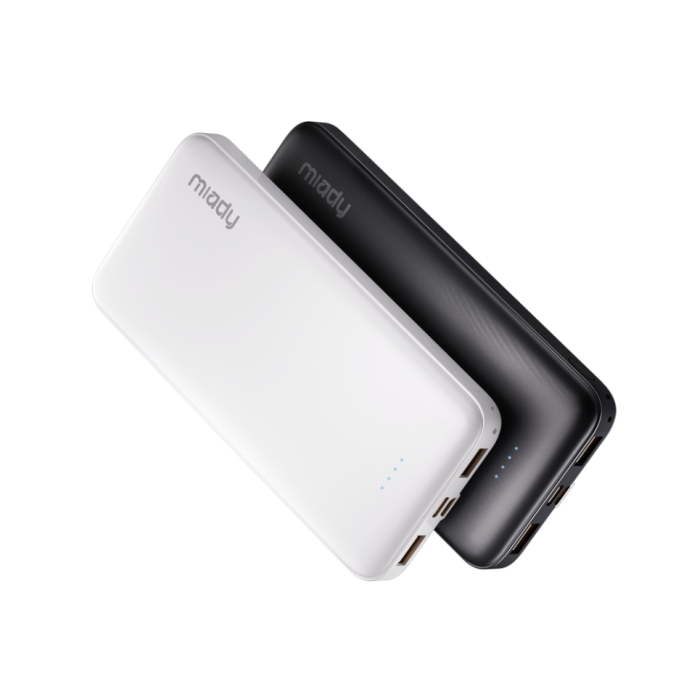
Miady AS-TPB21
Best Value Power Bank
CleverHiker Rating: 4.3/5.0
Price: $22
Weight: 8 oz.
mAh: 10,000
Time to full charge: 5 hrs
Pros
- Affordable
- Two power banks for the price of one
- Performs well in cold weather
Cons
- Not much power in comparison to its weight
- Slower recharge time for its size
The cheapest power bank we have found for backpacking, the Miady is sold as a two-pack. During our tests, its overall performance was not as strong as some of the other battery packs we looked at, but it’s hard to beat its price point. It tends to perform towards the bottom of our top tier 10,000 mAh power banks: it was a bit heavier on our scale, has a larger volume, and took four and a half hours to recharge from empty. Its efficiency is also pretty low, but that is to be expected for the price. In our experience, many of these qualities were not overly noticeable in the field and it still worked well enough to get the job done.
We did find that the Miady performs well in colder temperatures with higher efficiency than any other 10,000 mAh battery pack and it holds up just fine to being dropped on the ground. Overall, this power bank is solid enough that we would recommend it to beginner backpackers just getting started or those who are on a very tight budget.
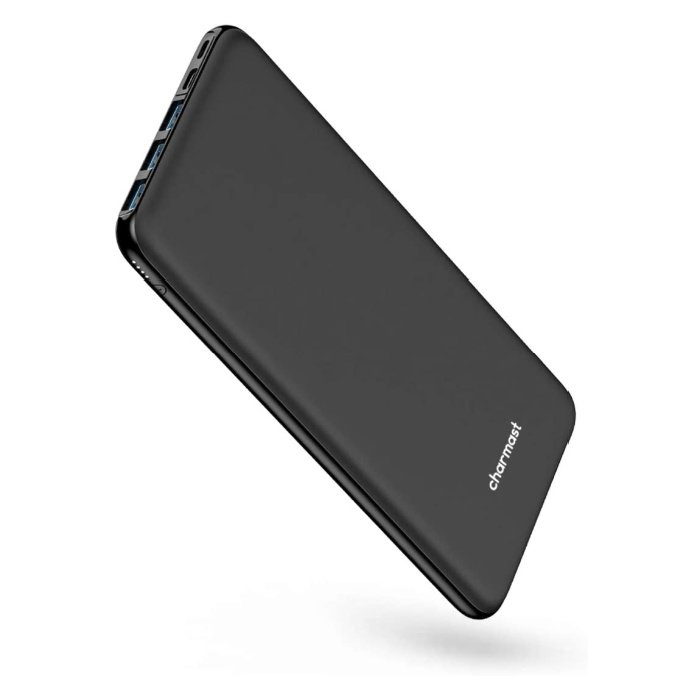
Charmast 26800 mAH Portable Charger
Best Large-Capacity Power Bank
CleverHiker Rating: 4.3/5.0
Price: $30
Weight: 12 oz.
mAh: 26,800
Time to full charge: 7 hrs (USB-C)
Pros
- Excellent value
- High charging capacity
- Charges multiple devices at once
- Lots of power in comparison to weight
Cons
- Loses capacity in cold temperatures
- Takes longer to charge than some
At 26,800 mAh, the Charmast is the largest capacity power bank we tested and also one of our favorites. We were pleasantly surprised to see it frequently beat out smaller-capacity power banks in areas such as weight on our scale, power-to-weight output, portability, and durability. On backpacking trips, we often find ourselves reaching for this bank over many of the other high-capacity power banks and are impressed by its thin, sleek design.
Some notable wins for this power bank include its top-tier weight ranking compared to other high-capacity power banks and its strong performance in our lineup of most efficient battery packs. That just means it packs a lot of power in every ounce.
In addition to its base features, we find it easy to use. The Charmast sports three input and four output ports, allowing maximum flexibility. One of the output ports supports quick charging, and this power bank automatically initiates trickle charging for small electronics. For backpackers looking for the most power in one of the best-designed banks, look no further.
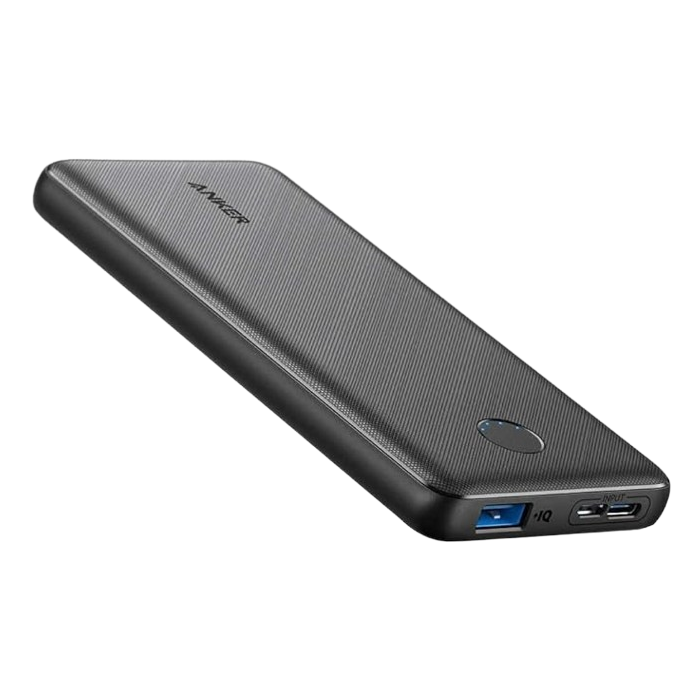
Anker Powercore Slim 10000
Incredibly Reliable Power Bank
CleverHiker Rating: 4.2/5.0
Price: $24
Weight: 8.5 oz.
mAh: 10,000
Time to full charge: 5 hrs
Pros
- Reliable
- Affordable
- Trickle charge mode
Cons
- No pass-through charging
- Poor performance in cold temperatures
With a simple, no-frills design, the Powercore Slim fits the bill of ole’ reliable, just like most Anker products we have tried. The Powercore Slim seemed to float around the middle of the pack or a bit below in almost every category we tested. More specifically, it took an hour longer than any other 10,000 mAh power bank to recharge from empty and it doesn’t have much power available per ounce. The most significant point against it is its lack of pass-through charging. It is the only model we tested that didn’t offer that feature.
That said, when being handled it is obvious that this model is built of sturdier materials than most of the other 10,000 mAh battery packs. This is especially true when comparing it to other affordable options. As such, we still like this power bank overall as an affordable 10,000 mAh option and we would put our trust in the Powercore Slim to complete a thru-hike.
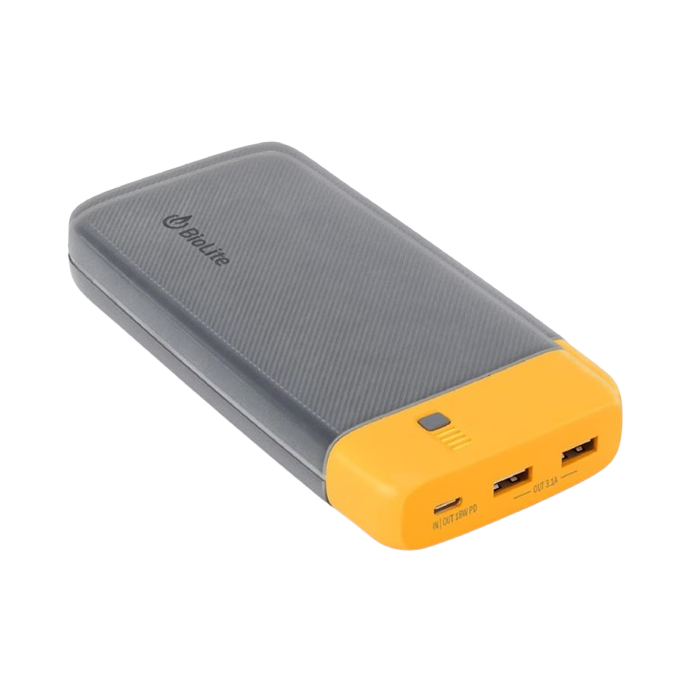
BioLite Charge 80 PD
Best Durable Power Bank
CleverHiker Rating: 4.2/5.0
Price: $80
Weight: 1 lb. 1 oz.
mAh: 20,000
Time to full charge: 4 hrs
Pros
- Durable
- Charges quickly in comparison to capacity size
Cons
- Heavy & bulky
- Charge indicator can be difficult to read
The BioLite Charge 80 PD is a bit large for a 20,000 mAh power bank but is also highly durable. It is one of the few power banks we tested with no visible scratches after heavy use in the field. When held in the hand, it feels well-made and it is evident that it can stand up to use in the backcountry. We also like that it recharges faster than any of the other large-capacity power banks we tested, helping to save us time and potentially money.
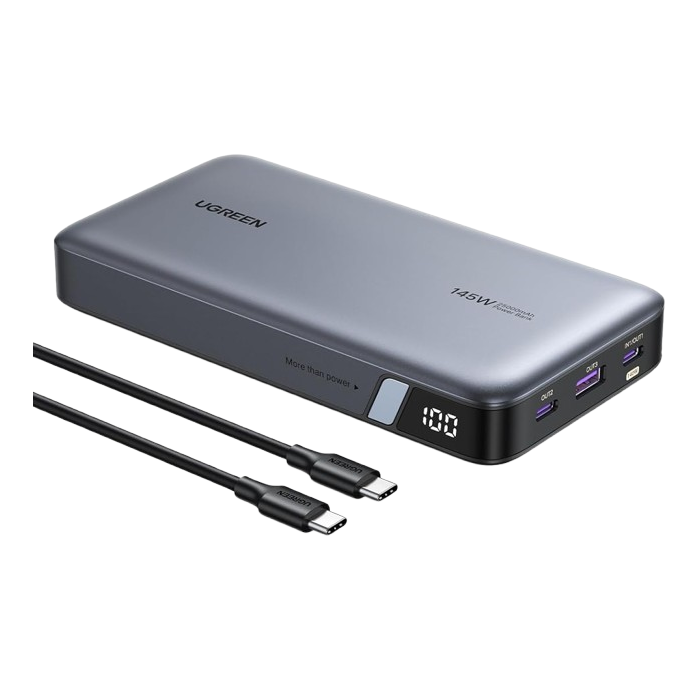
UGREEN 145W
Best Power Bank for Charging Large Devices
CleverHiker Rating: 4.1/5.0
Price: $120
Weight: 1 lb. 1.8 oz.
mAh: 25,000
Time to full charge: 2 hrs
Pros
- Digital charge indicator
- Ability to charge large devices quickly
Cons
- Heavy & bulky
- Expensive
- Need a specific charger for faster recharging
Sometimes, it’s nice to bring luxury items such as tablets into the backcountry, and the UGREEN 145W power bank is there to help. With a 140W output port and 25,000 mAh capacity, this battery pack is an excellent choice for charging larger electronics. This is especially true with a digital display that makes it easier to monitor power consumption.
The downside to these features is added weight and expense – the UGREEN is the heaviest and most expensive power bank we tested. This model can be a solid choice in specific situations, but it is probably not the choice for everyone.
More: UGREEN 145W Full Review
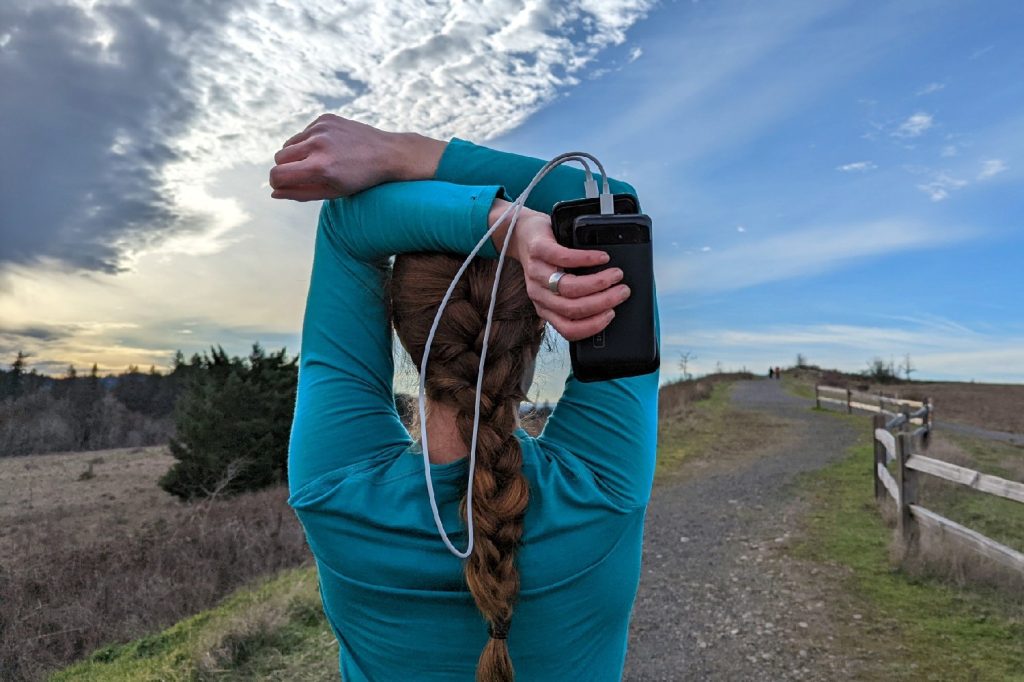
Product Comparison Table
| oSort | Product | Price | Weight | mAh | Time to full charge | Efficiency | Weight & Packability | Durability | Charging Speed | Features | Cold Charging | 0 |
Nitecore NB 10000 Gen 3 View at Amazon |
$65 | 5.3 oz. | 10,000 | 4 hrs (USB-C) | 4.8 | 4.8 | 4.6 | 4.2 | 4.2 | 3.9 | 1 |
OKZU 10000 View at Amazon |
$24 | 6.6 oz. | 10,000 | 3.5 hrs | 4.4 | 4.4 | 4.2 | 4.8 | 4.2 | 4.2 | 2 |
Goal Zero Flip 24 View at REI View at Amazon |
$30 | 4.8 oz. | 6,700 | 4 hrs | 3.6 | 4.9 | 4.5 | 4.5 | 3.9 | 4.9 | 3 |
Zendure Super Mini 10000 View at Amazon |
$27 | 6.6 oz. | 10,000 | 3 hrs | 4.1 | 4.6 | 4.5 | 4.3 | 4.2 | 4.5 | 4 |
INIU Megapower 10000 View at INIU View at Amazon |
$30 | 7 oz. | 10,000 | 5 hrs (USB-C) | 4.4 | 4.4 | 4.2 | 4.6 | 4.2 | 4.2 | 5 |
INIU 20000 PD View at Amazon View at INIU |
$33 | 12.2 oz. | 20,000 | 6 hrs (USB-C) | 4.7 | 3.9 | 4.2 | 3.7 | 4.9 | 3.9 | 6 |
Miady AS-TPB21 View at Amazon View at Walmart |
$22 | 8 oz. | 10,000 | 5 hrs | 3.8 | 4.2 | 4.2 | 4.1 | 4.2 | 4.7 | 7 |
Charmast 26800 mAH Portable Charger View at Amazon |
$30 | 12 oz. | 26,800 | 7 hrs (USB-C) | 4.6 | 4.0 | 4.2 | 3.5 | 4.9 | 4.2 | 8 |
Anker Powercore Slim 10000 View at Amazon View at Anker |
$24 | 8.5 oz. | 10,000 | 5 hrs | 3.8 | 4.1 | 4.2 | 3.9 | 3.7 | 4.2 | 9 |
BioLite Charge 80 PD View at REI View at Amazon |
$80 | 1 lb. 1 oz. | 20,000 | 4 hrs | 4.1 | 3.7 | 4.3 | 3.9 | 4.2 | 4.0 | 10 |
UGREEN 145W View at Amazon View at UGREEN |
$120 | 1 lb. 1.8 oz. | 25,000 | 2 hrs | 3.9 | 3.6 | 3.9 | 3.5 | 4.2 | 4.7 |
|---|
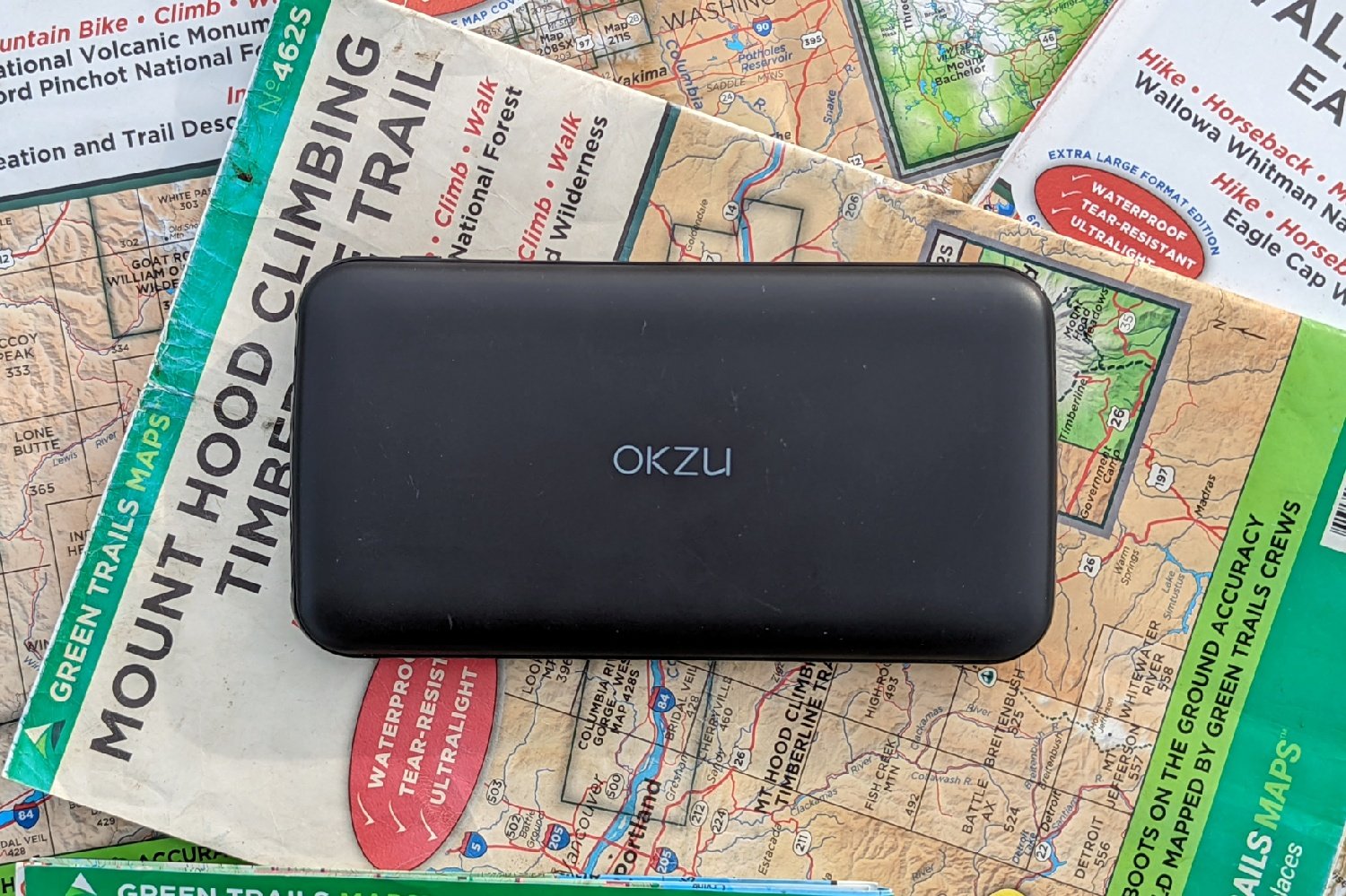
How We Test & Methodology
We rigorously tested each power bank using a variety of metrics to determine which is the best. Our process looked at efficiency, weight & portability, durability, charging speed, cold capabilities, and features. We spent several weeks charging and discharging each bank using a multimeter and dummy resistor load and toting each bank along on various overnight backpacking trips in the Southwest.
EFFICIENCY
Running out of or rationing batteries on a hike is no fun for anyone, so ensuring that each power bank provides the maximum amount of charge for its size and weight is essential. To guarantee that our results were as accurate as possible, we used a multimeter and dummy resistor load to draw power from each bank. At the end of our tests, we performed some calculations and compared our line-up based on the amount of available power per gram.
WEIGHT & PACKABILITY
One of the simplest metrics, weight, is a frequent make-or-break factor when choosing a power bank. It is common for the market weight and actual weight to differ, so we were sure to place each power bank on our scale when testing. Each bank measurement was recorded in grams to make it easier to compare and to be used in later tests.
We also looked at how portable each model was. Fitting a power bank into a pocket or fanny pack can provide an abundance of convenience when phone batteries start to run low. We measured all of the power banks we tested to obtain their actual measurements and then calculated their total volume.
DURABILITY
No one wants to carry a power bank that has stopped working in the backcountry, so we evaluated each power bank for durability. Our tests included dropping each power bank from a height of eight feet, carrying them around with us over the course of several weeks, and using them in the field to ensure that they could handle the rigors of the outdoors.
CHARGING SPEED
Being tied to an outlet can range from inconvenient on a backpacking trip to downright costly if on a thru-hike. Larger capacity power banks, such as those over 20,000 mAh, tend to take longer to recharge than smaller banks around 10,000 mAh, but there is variance within each capacity range. Charging cord quality, outlet plugs, and the bank’s ability to accept power also impact charging time. To better compare charging time, the same 3.0 QC wall charger and standard USB-C cord were used to recharge each bank from empty to full.
FEATURES
These tests focused on power bank features with a big emphasis on pass-through charging. We plugged each power bank into the wall charger and then plugged a phone into the power bank to see if the charge would pass through the power bank and into the phone. We also looked at other features, such as the number of input and output ports, the ability to provide a trickle charge to smaller electronics, and how easy the battery indicator display was to read.
COLD CHARGING
Sometimes, cold weather can move in unexpectedly in the backcountry; ideally, a power bank’s ability to recharge your phone should not be compromised. To evaluate cold weather performance, we used our multimeter and dummy resistor load to draw power from each bank while sitting in the refrigerator. From there, we could compare the results to those in our efficiency testing and rank which banks performed the best in the cold.
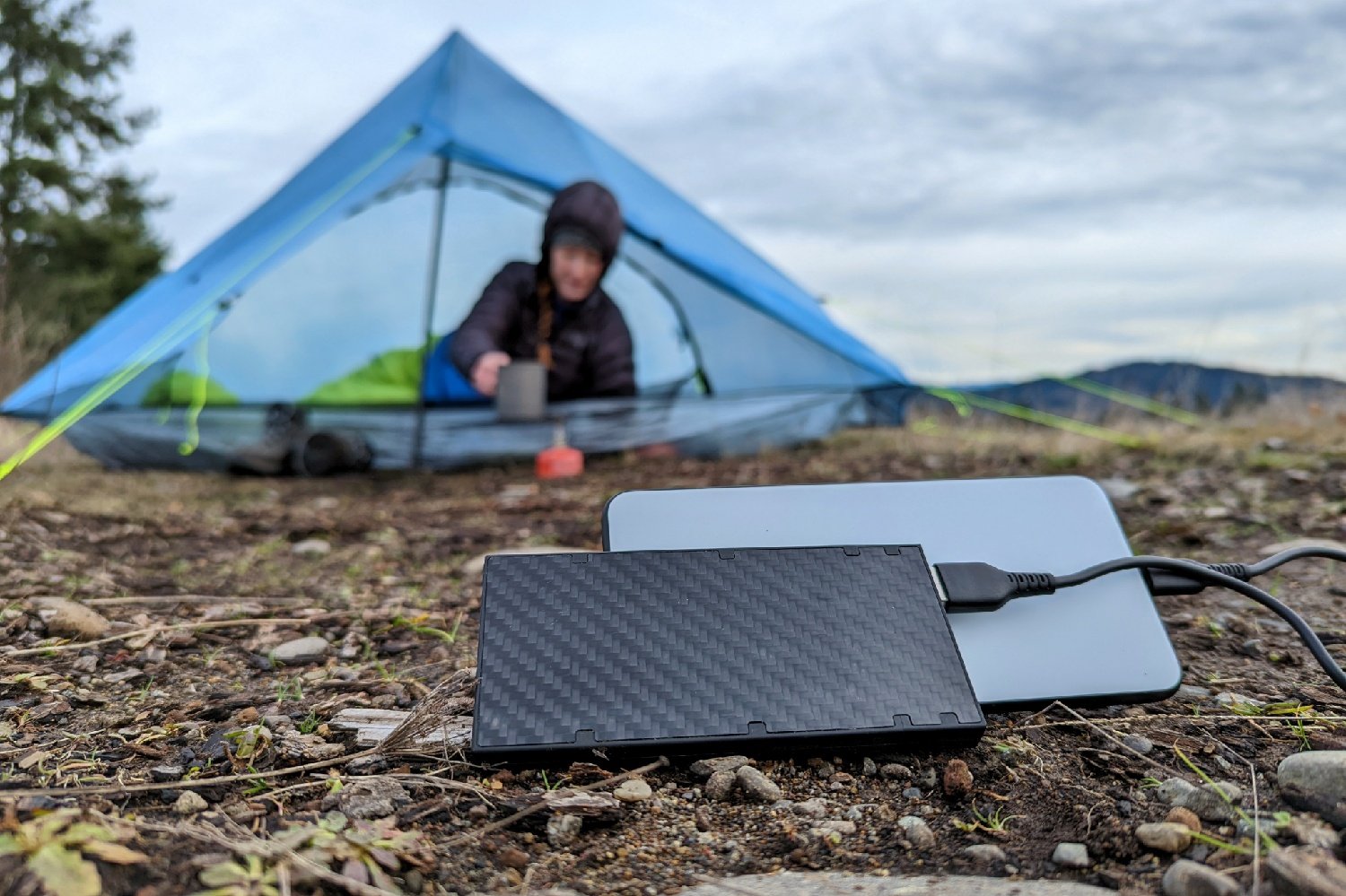
Why Trust CleverHiker
Gear Analyst, Bailey Bremner, has spent over 600 nights and nearly 8500 miles on trails across the U.S. with various power banks. She has relied on electronics extensively for navigation while hiking original routes such as the Western Wanderer Route, Columbine Route, and San Luis Loop along with more mainstream trails such as the Colorado and Continental Divide Trails. While bushwhacking through the wilderness, she has learned firsthand the importance of reliable gear and has made it her mission to become an expert on backpacking equipment.
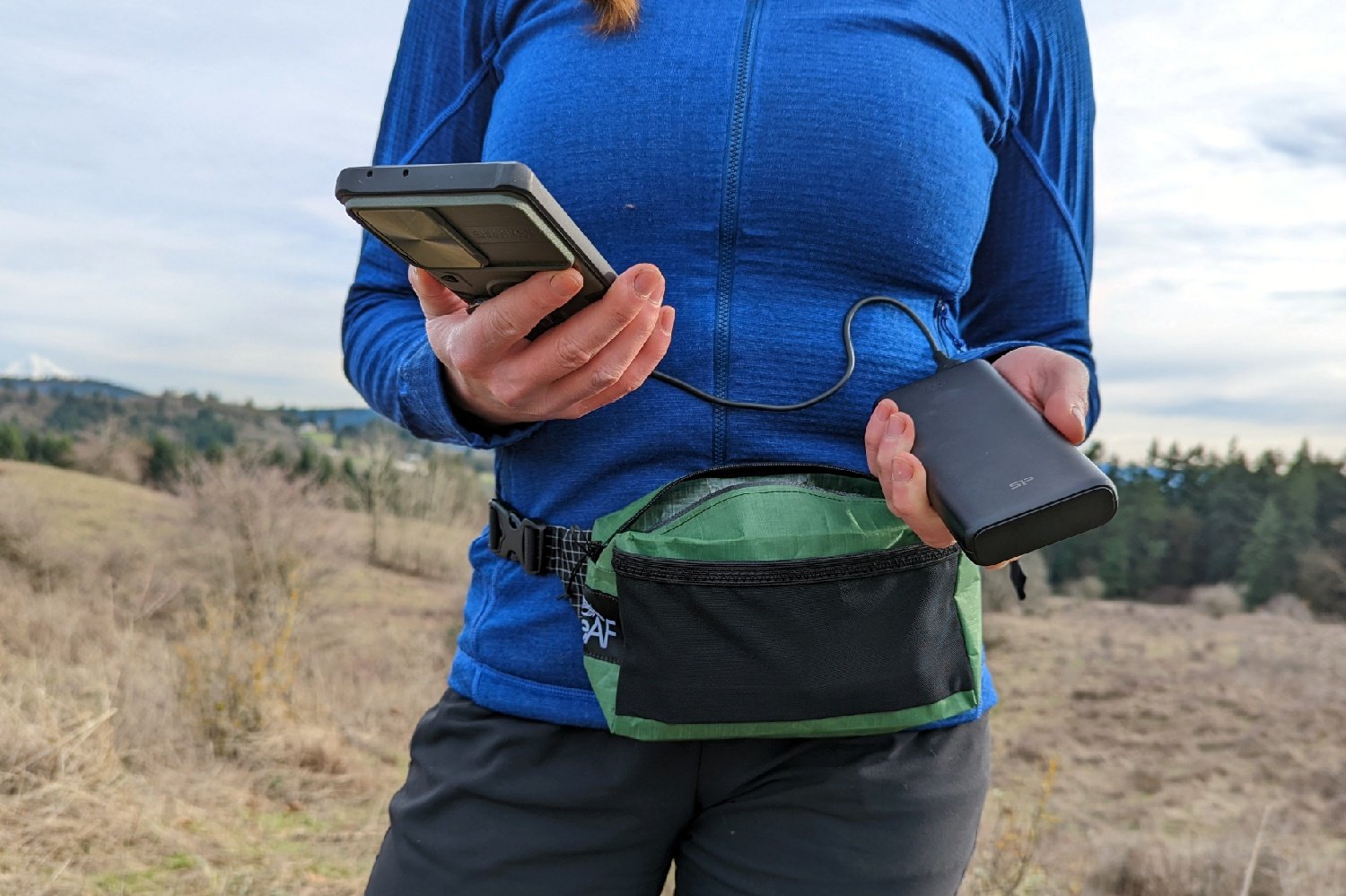
Analysis & Results
We rank power banks based on six metrics: efficiency, weight/packability, durability, charging speed, cold capabilities, and features Our comparative results below outline the top performers in each metric.
VALUE
Power bank value is about how much performance you get for your money. This means both high-quality options that go above and beyond are a good value, as are less expensive options that outperform their price point. Fortunately, there are tons of solid options at reasonable prices.
The Nitecore NB 1000 Gen 3 is among our favorites overall, and its reliable efficiency and packability make it a high-value pick as well. The INIU Megapower 10000 has the portability and the charge speed to make it a truly worthy contender at a fair price, and the OKZU 1000 is also lightweight and even faster still – at an even lower price.
EFFICIENCY
This was one of our most involved and rigorous tests, involving extra equipment and mathematical calculations to ensure a high level of accuracy. After draining all of our power banks to empty, we calculated each bank’s total Watt hours (Wh). To make the test fairer and more useful for backpackers, we compared the Watt hours to the weight of each bank to better evaluate how much power is available per gram you are carrying.
After weeks of testing, Nitecore NB 10000 Gen 3 once again rose among the ranks, demonstrating that it is feather-light and packs a lot of power into its small frame. The INIU 20000 and Charmast were not far behind, demonstrating that those banks are worth the extra weight for those who need more charges in the backcountry. The INIU 10000 and OKZU performed just above average for those looking for a more affordable but still efficient 10,000 mAh option.
The Zendure power bank was just slightly below average with the BioLite and UGREEN power banks trailing behind. These would not be our first choice for efficiency, but they aren’t terrible. The Anker PowerCore Slim and Miady came in at the back of the pack after testing and the Goal Zero Flip had the worst efficiency per gram of power bank.
WEIGHT & PACKABILITY
A top consideration for many backpackers, power bank weights can vary greatly. We weighed each product and considered how compact each one is in a pack. The Goal Zero Flip 24 led the charge at a scant 0.30 pounds, with the Nitecore NB 10000 Gen 3 in hot pursuit at 0.33 pounds. This comes as little surprise, given Goal Zero’s small capacity and Nitecore’s reputation as an incredibly light power bank.
The rest of the 10,000 mAh power banks, specifically the Zendure, OKZU, INIU 10000, Miady, and Anker PowerCore Slim, all fell within 0.1 pounds of each other, making the weight difference reasonably negligible. As expected, the larger capacity power banks scored much lower due to their larger battery cells. Within the class of larger power banks, the Charmast was the lightest at 0.75 pounds, and the INIU 20000 weighed just slightly more. Both the BioLite and UGREEN models weighed just over a pound and felt significantly heavier than the other power banks we tested when used in the field.
The size difference between the smallest and largest power banks in our lineup is pretty apparent to the naked eye, but for the sake of thoroughness, we measured each power bank’s length, width, and height. The Goal Zero Flip was the smallest bank, with the Nitecore NB 10000 in hot pursuit. These banks and the Zendure were our go-to choices when using power banks in the field, as they were always the most convenient to use while hanging out in the tent at the end of the day or topping off our phones first thing in the morning.
Again, the other 10,000 mAh power banks had similar measurements. Of the larger capacity options, the Charmast was the most compact with its wide, but thin design. The INIU 20000 was just a bit larger. We loved the Charmast’s design particularly given its large capacity, but it is splitting hairs and will come down to user preference. Both the BioLite and UGREEN are large and bulky making them more difficult to travel with than the others on this list.
DURABILITY
Over the course of our testing, almost all the banks showed some minor signs of wear and tear in the form of scratches, though the Goal Zero, Zendure, and Nitecore models had less visible wear than most.
The exterior on the BioLite power bank also was more durable than average. In the field, we didn’t have any issues with the performance of the OKZU, INIU 10000, INIU 20000, Charmast, Miady, or Anker power banks despite their appearance.
More importantly, when we dropped all of the power banks from a height of eight feet, all but the UGREEN could charge a phone immediately. The UGREEN did still work, but it had to be plugged in and recharged before it would turn on again.
CHARGING SPEED
The OKZU 10000 smashed our charging speed test, moving from dead to fully charged in just two hours and 36 minutes. The INIU 10000 and Goal Zero were 40 and 50 minutes behind that time, respectively.
The Goal Zero was slow to charge which is surprising given its smaller capacity. The rest of our 10,000 mAh power banks took anywhere from three hours and 44 minutes to four and a half hours to recharge, with the Zendure, Nitecore, and Miady performing above average.
The Anker Powercore Slim was well below average for its capacity category, taking about five and a half hours to recharge. This was just slightly faster than the BioLite, which was the fastest of the large-capacity banks we tested.
The INIU 20000 took about 15 minutes longer than the BioLite. The largest banks in our lineup unsurprisingly took the longest. The UGREEN recharged in six hours and 39 minutes, with the Charmast taking about 10 minutes longer. It is worth noting that these charging times could be sped up with a different charging cable or wall adapter, but for our tests, we wanted to keep things equal across the board.
FEATURES
Almost every power bank we tested had at least a few features, though some were simpler than others. Most power banks had at least two charging ports and could charge multiple electronics at the same time. The UGREEN and INIU 20000 are the only options with digital displays, and both INIU models also have built-in flashlights. We really love how many plug-in ports the Charmast power bank has, which makes this model very flexible to use.
The common features of two or three ports, pass-through charging, and trickle charging in the Nitecore, BioLite, Zendure, OKZU, and Miady made them all fairly comparable. Choosing these banks based on features is going to come down to user preference. For example, we were not wild about the Nitecore NB 10000 Gen 3’s lack of a USB-B port, but others may find that only having USB-C ports is a benefit.
Towards the bottom of the lineup, the Goal Zero Flip offers very few features but does at least have pass-through charging. The Anker Powercore Slim was the only model that doesn’t support pass-through charging, and the trickle charging function was inconvenient to use, so we ranked this model last.
COLD CHARGING
For hiking in shoulder season or places that get cold at night, the Goal Zero Flip 24 not only meets but exceeds its warm-weather performance with increased efficiency. The UGREEN 145W and Miady banks also performed better in cold weather, which makes them a great choice for charging electronics early in the morning when the grass outside is still a bit frosty. The Zendure is the final power bank that had an increase in capacity when tested in cold weather, though just by a small amount.
Out of the models we tested that had a lower capacity in the cold, the BioLite had the smallest loss with the INIU 10000, Anker, Charmast, and OKZU all trailing behind in that order. The INIU 20000 and the Nitecore banks performed the worst in the cold during our side-by-side test. The loss in capacity was very noticeable with the Nitecore power bank when used to charge phones at night on backpacking trips in the San Juans.
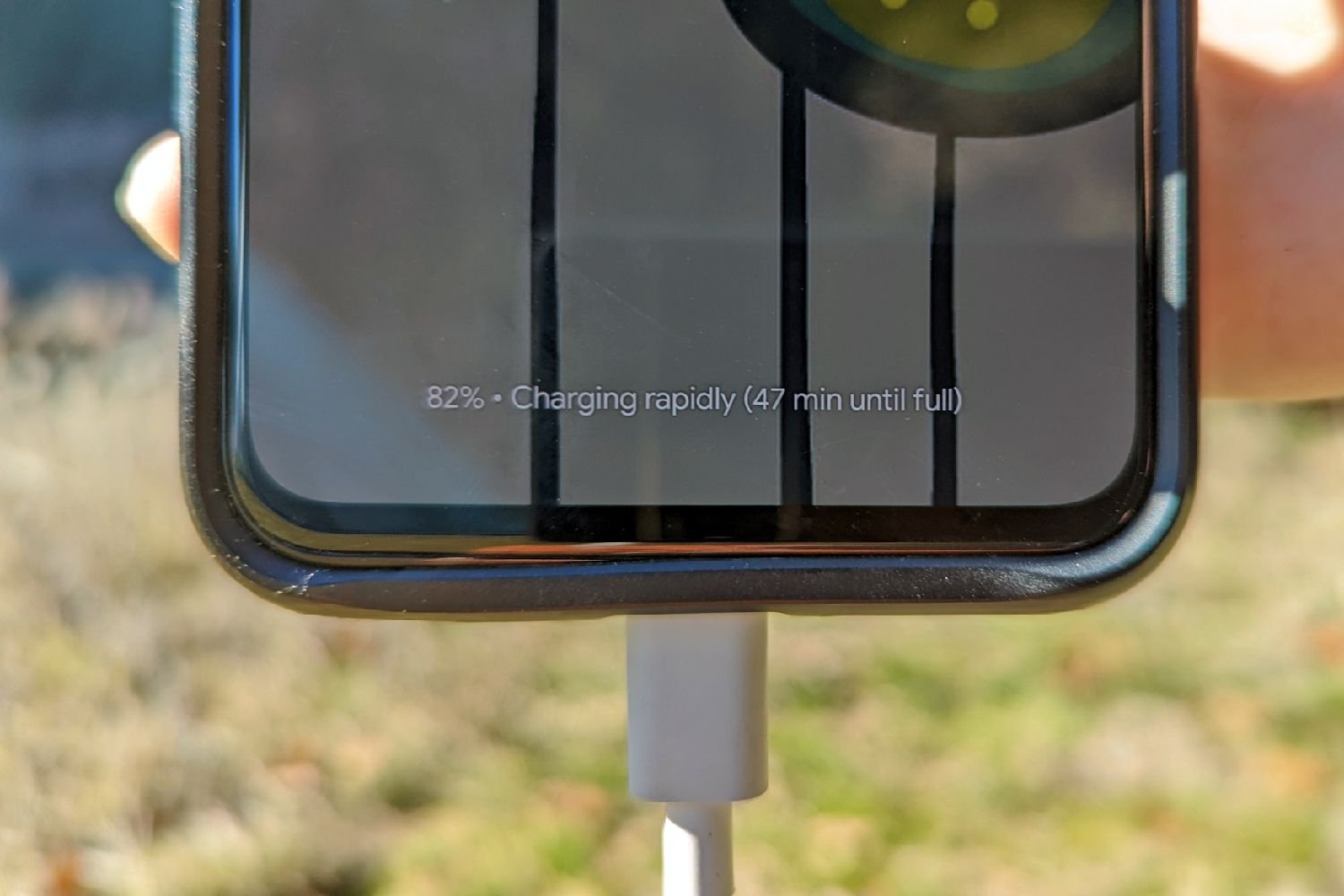
How to Choose a Power Bank
CAPACITY
We like to divide power banks into subcategories based on the power capacity they provide. Most banks can be split into single charge power banks, those that fall into the 10,000 mAh range, the 20,000 mAh range, and large capacity banks that approach the 27000 mAh size. When purchasing a power bank, it is important to consider how much juice is likely to be required before the next opportunity to recharge. 10,000 mAh power banks tend to provide approximately two full phone charges before running out.
However, factors such as phone size, whether the phone is being charged over 80%, the outside temperature, and the efficiency of the power bank all impact how much usage is available before running out. There is also some debate on whether choosing to pack out one 20,000 mAh bank or two 10,000 mAh banks is the better choice; it will just depend on each use case.
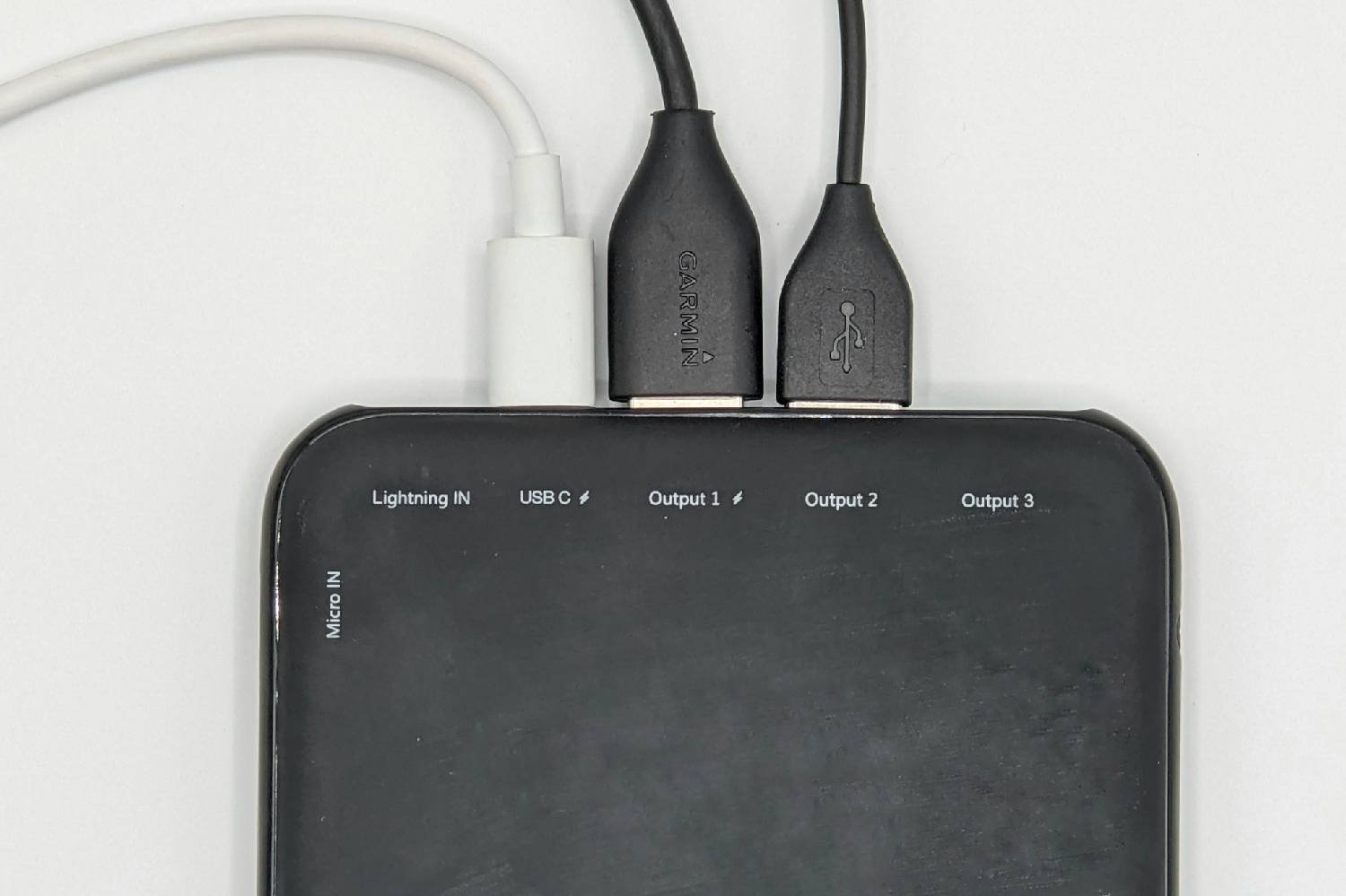
WEIGHT
Like any other backpacking item, weight is always a top consideration. Due to the size of the internal battery, smaller-capacity power banks will almost always weigh less than their higher-capacity counterparts. Choosing a power bank with just enough capacity to keep everything charged on a standard trip is helpful so that extra battery weight isn’t being lugged around.
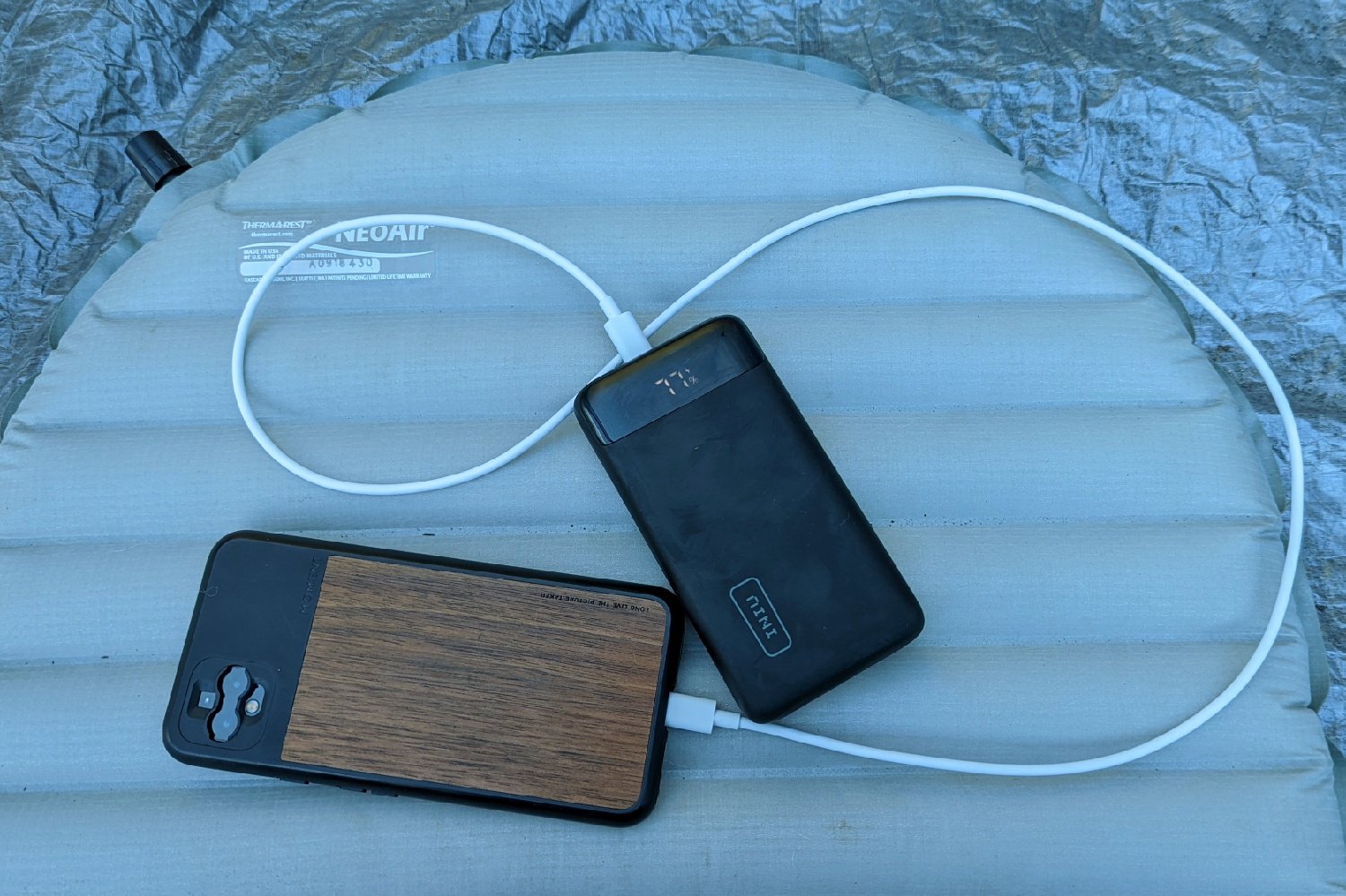
PRICE
You can buy a decent power bank at a surprisingly wide range of prices. Unlike many other pieces of gear, a higher price tag doesn’t necessarily correlate with improved performance or weight. For beginner backpackers or those on a budget, many solid options are available that won’t break the bank.
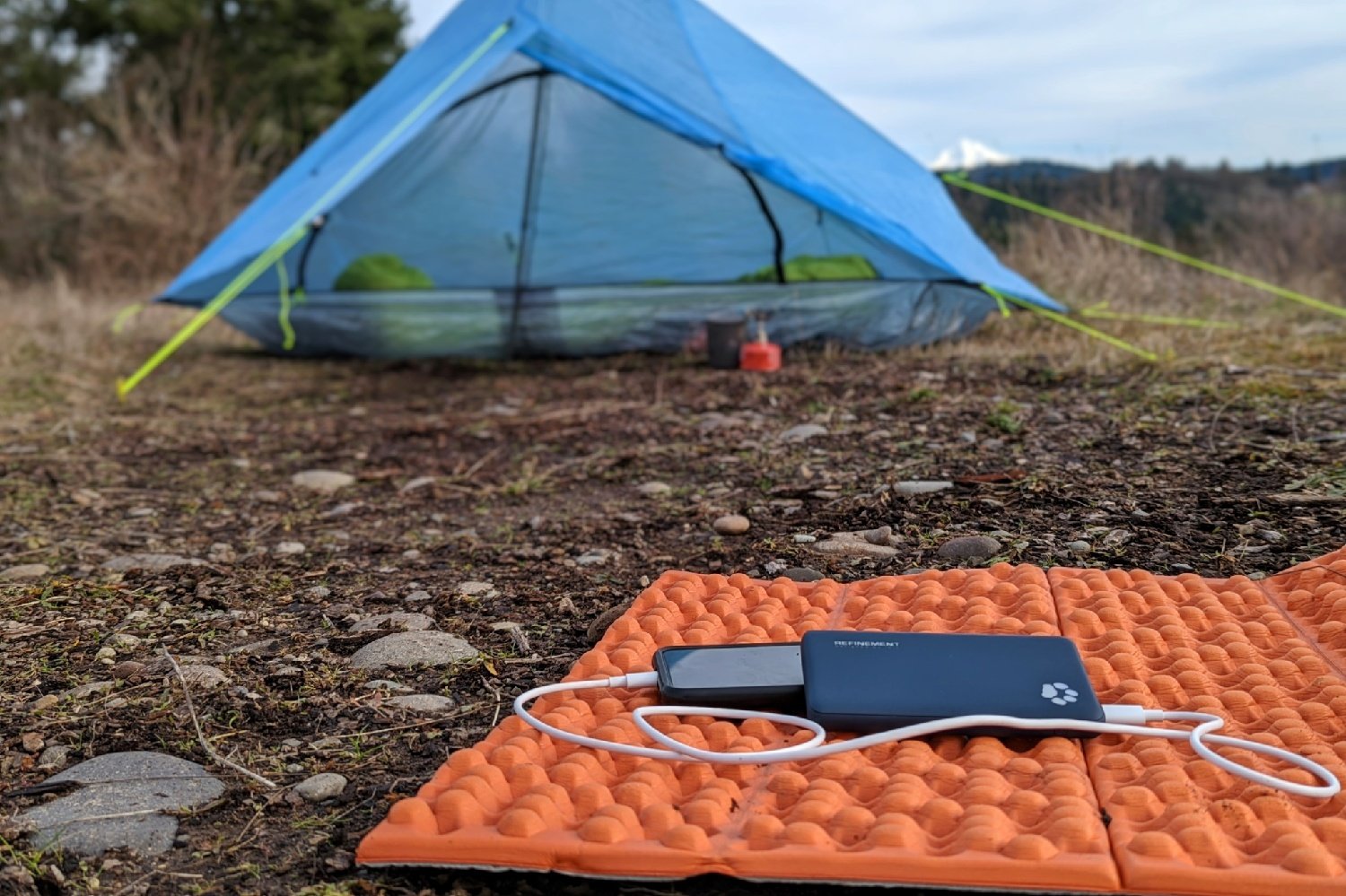
FEATURES
Whether looking for a simple interface or searching for a bank with multiple ports, many features are available across the different models. Some power banks sport just two simple ports, one for intake and another for outflow of charge. Others have up to five different ports, including both USB-A and USB-C. Most power banks allow for pass-through charging, enabling a phone and the bank to charge simultaneously. Finally, various charge indicators exist, including blinking bars and digital percentages. It should be noted that most charge indicators, even the digital kind, are not 100% accurate.
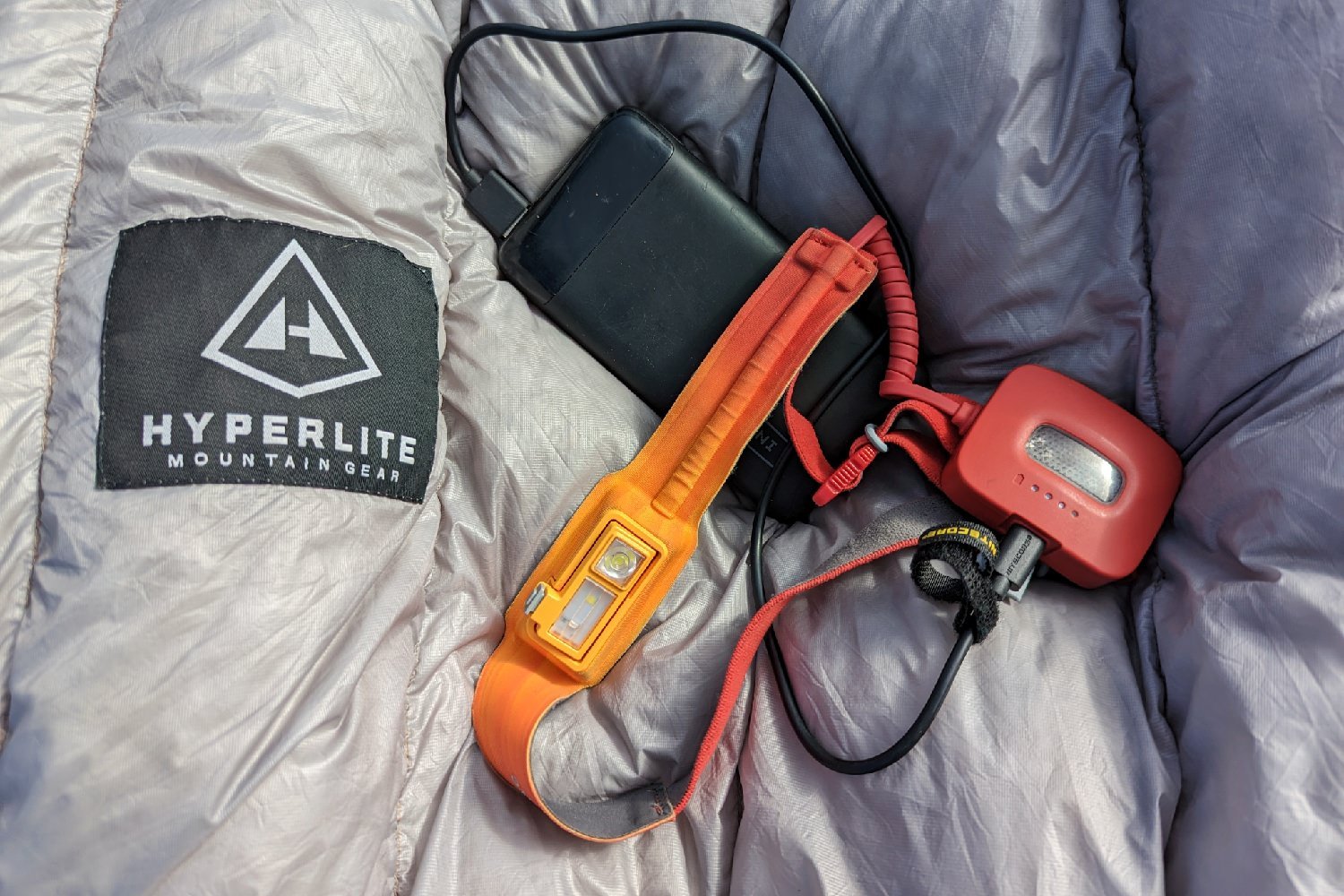
Conclusion
It can be easy to get lost in the weeds when trying to understand power bank technical specs and features. Our hope is that this guide has cleared the air and helped you find the perfect power bank to keep you safe and connected in the backcountry.




